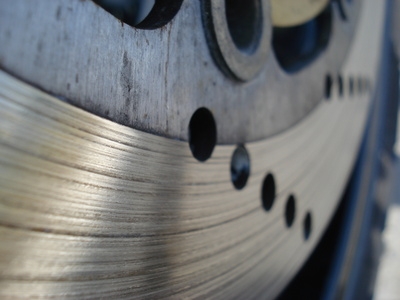
Diagnosing an annoying brake squeal is like trying to diagnose a bad headache. The symptoms are obvious, but it is virtually impossible to pinpoint a single underlying cause. Fortunately, brake squeal is not a headache although it can perhaps give one to the driver. Squeal can be caused by a combination of factors that sometimes add up to create the noise. It can also be a symptom of bigger brake problems.
Determine where the brake squeal is coming from. Drive slowly in an empty parking lot and brake frequently while carefully listening for the squeal. Note if the brakes squeal when they are applied or if the noise is present, while driving, then disappears when the brakes are applied. Determine if the noise is coming from the front or the back and if it's from just one wheel or more. Focus your diagnostic efforts on the wheel or wheels that are the main source of the noise. If the brakes are new and the noise is not alarmingly so, give the new brakes a couple of weeks to wear in to see if the noise goes away.
Check the thickness of the disc pads and be sure it exceeds the minimum specified for your vehicle (typically 5/64 to 3/32 of an inch for passenger cars). Some pads are fitted with a looped metal leaf wear indicator that will rub on the disc when the pad reaches minimum thickness. These are usually fitted on the inside pads only. The indicator will produce a squeal that will often go away when the brakes are applied. Replace worn-out pads. Uneven brake pad wear can result in uneven pressure between the pads, sometimes causing a squeal during braking. This normally indicates a seized caliper. In this case, the caliper slider pins should be thoroughly lubricated and new disc pads installed.
Examine the back of the disc pad backing plates to see if shims are present. Soft shims are commonly used here to absorb high frequency vibration and reduce noise. Occasionally, they can detach and fall off. Replace any that are missing and install them if they are not present.
Check the surface of the disc pads and the discs. Sometimes material can become embedded in the pads. Heavy or severe use can cause the surface of the pads or the disc to become glazed. Dust, either from the road or from brake pad wear, can sometimes form a layer on one or more pads. If any pad or disc surfaces don't look right, then the parts should be replaced.
Inspect brake drums and shoes if the vehicle is equipped with drum brakes. Squeal is often the result of dust accumulation inside the drums. Check the condition of the shoe linings. The lining thickness should exceed the minimum specified for your vehicle, and the wear should be even. The surface should be free from contamination and should have an even and unglazed appearance. Defective parts should be replaced; and if uneven wear is noticed, then the brakes should be thoroughly checked for proper alignment, bent backing plates and proper return spring operation.